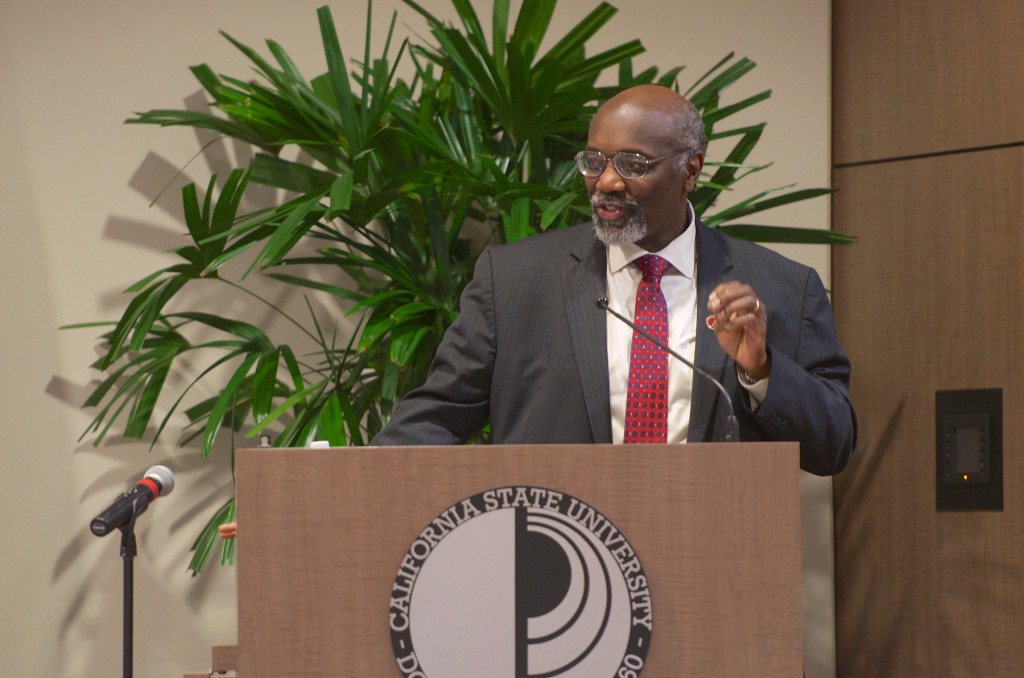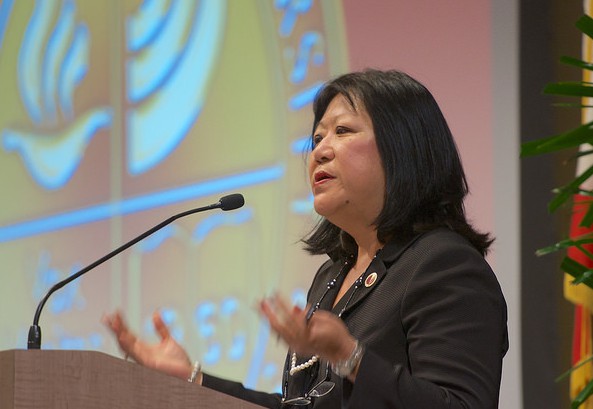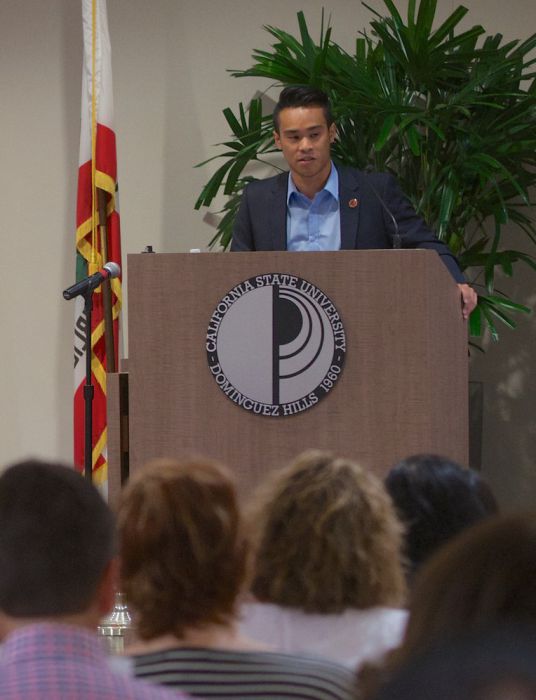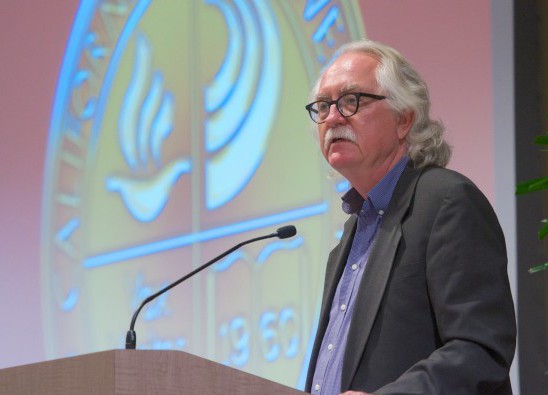 With his sights on the future, California State University, Dominguez Hills’ (CSUDH) President Willie J. Hagan told the more than 250 faculty, staff and students who attended the 2014 Fall Convocation that the state of the university is strong and poised to achieve its full potential.
With his sights on the future, California State University, Dominguez Hills’ (CSUDH) President Willie J. Hagan told the more than 250 faculty, staff and students who attended the 2014 Fall Convocation that the state of the university is strong and poised to achieve its full potential.
Just one month into the fall semester, Hagan has enjoyed meeting new faculty and staff, a large number of the 4,200 new students on campus, including approximately 1,100 freshmen during the university’s first Freshman Convocation, and some of the 770 new graduate students.
“You’ve all joined a great family. I learned that myself when I arrived here 27 months ago. You represent the constant growth and evolution of the campus. You bring new ideas and personal circumstances that will enrich us all,” he told to the “new faces” in the convocation audience.

Hagan, who was introduced by convocation emcee Provost and Vice President for Academic Affairs Ellen Junn, also reflected on how “honored and humbled” he was during his investiture on May 2 when he was inaugurated as the 10th president of CSUDH. He thanked the audience by saying his investiture was an “amazing turning point in my life.”
“I was in awe of the way this campus showcased itself to our guests, our friends, and to the external community,” he said. “From the day of service that kicked off the week-long activities and a series of outstanding inauguration lectures, to the Women in STEM conference and the Student Research Symposium, as well as the President’s Student Leadership and Service Awards and the Community Engagement Symposium… All of this culminated into the combined Presidential Inauguration and President Scholarship and Awards Dinner, which raised more than $472,000 in scholarship funds.”
A Future Built on Today’s Victories
Choosing not to focus on enrollment, data or budget issues, except to say that the budget is “better, not great, but better,” Hagan instead addressed such topics as recent accomplishments, upcoming developments, and the future.
“So let’s talk about our future, but first from the perspective of the educational foundation on which it has to be built,” he said. “By foundation I mean our educational programs, and our resources, which include the people, money, facilities; the tools that let us do our job and support infrastructure, our policies and practices, and our time.”
President Hagan believes the university has made “good strides” in hiring highly qualified faculty and staff, and that this year more academic advisers will be employed. He also praised Interim Vice President for Enrollment Management and Student Affairs William Franklin and “his team” for tripling the size of the Summer Bridge Program, which advises students who need additional support in math and English.
“The Bridge Program has been so successful that it is recognized nationally,” said Hagan. “Students who complete the Bridge Program have year-to-year transition rates exceeding many of the students who arrive in need of no additional preparation.”
Other recent additions aimed at improving students’ academic success that Hagan discussed include the establishment of the Undergraduate Research, Scholarship and Creative Activities Institute and the Center for Innovation in STEM Education, as well as next month’s launch of an interdisciplinary research grant program.
Hagan thanked the Division of Information Technology (IT) and Facilities Planning and Construction Management for their work in renovating 17 classrooms on campus and developing plans for additional renovations over the next several years. He also believes the construction of a student recreation facility is “long overdue.”

“These are all critical improvements to our foundation,” Hagan said. “At the same time we are looking to acquire funds to build new classrooms, laboratories, research and performance facilities. I’m optimistic that we are going to be successful in many of these funding efforts.”
Associated Students, Inc.’s (ASI) President and CEO Chris Fernandez had ASI wins to share as well.
Fernandez, a candidate for a Rhodes Scholarship, said that next month the College of Business Administration and Public Policy’s Business Entrepreneurial Center will open its doors, giving students the opportunity to propose business ideas and have access to the resources to help launch them. He also said that ASI has recognized more than 50 new organizations that may now seek information and funds for events and resources.
“So far we have done some great things within ASI–in how we collaborate with faculty, staff and administrators,” said Fernandez, who will graduate in spring 2015 with a bachelor’s degree in biology. “We have also partnered with a company called True Market Solutions to initiate sustainable projects and to create a sustainability action plan that we hope to propose to the university.”
Fernandez also announced the creation of three new positions in ASI related to sustainability, veteran affairs, social justice and academics to better equip the organization to engage and understand the student body.
Another critical change to a successful future is the improvement of the university’s policies and practices, according to Hagan, particularly those that relate to employee compensation.
“We need to look at our own practices related to hiring and salaries at appointment,” he said. “I am hopeful the bargaining process will address many of the important issues we are facing. Once the system-wide agreements are reached, and the impact on our campus has been determined, I will in good faith review and consider the compensation issues of this campus and will act appropriately.”
Acknowledging that addressing the university’s budget deficiency is “long overdue,” Hagan believes it’s time for CSUDH to look beyond its deficiency needs and toward the future.
“I understand that who we want to be, and in some cases who we can be, will be impacted by the context within which we exist,” he said. “We exist in a state that has backed away from its original position of being a leader in providing higher education to its citizens. But California is not alone. So many in our nation, at least those in positions of leadership, seem misguided in their perspective and support of higher education.”
Playbook for the Future
Hagan is adamant about CSU Dominguez Hills’ need for a comprehensive Strategic Plan and its role in serving the university’s needs today and “for the next round” of new faculty, staff and students. He wants a plan that’s crafted with full campus involvement and one that “describes who we are now and where we want to go.”
“…Not a plan that is trucked out when accreditors show up. Not a plan that sits on a shelf. We need a plan that sits in the hands of our budget community, that sits in the hands of the President’s Cabinet, and that sits in the hands of the Academic Senate,” he said. “We need a plan that sits in the hands of all of those who helped create it. We have to act from the same playbook.”

Similar to how the president aligned the Strategic Plan as a document for CSUDH’s future, Anthropology Professor and Chair of the Academic Senate Jerry Moore revisited a document from early U.S. history as a sample of a new nation’s acknowledgment of the need for an educated public.
A Bill for the More General Diffusion of Knowledge, penned by Thomas Jefferson, is considered one of the most enduring works on the subject of education in the nation’s history. Jefferson saw that the future of American democracy required an educated people and that their education should be supported, according to Moore.
“Here’s a curious truth. Documents like these often contain the seeds of unanticipated fruits. In 1868, when the 14th Amendment was passed no one anticipated that it would result in Brown vs. The Board of Education, or that that amendment would be extended to the right of woman to have an abortion,” Moore said. “Yet such documents provide the logical and legal foundation of who we are in America. Jefferson’s A Bill for the More General Diffusion of Knowledge inadvertently anticipated what we do at this university…provide an outstanding university education without regard to wealth, birth or other condition or circumstance.”
He added, “If the spirit of Thomas Jefferson where to walk out [on campus] and see the slogan ‘America Happens Here,’ he would immediately know what we do. And so should we.”
Back to the Future
President Hagan believes that a good way of looking at the future is by looking back at it. He pondered how he and CSUDH faculty, staff and students will perceive the university decades from now.
“Now I know exactly what future I want to look back on. I will look back on an institution born literally out of the death and destruction, the moral indictment, the human sadness of the Watts Riots of the mid-1960s. I will look back on an institution that fully embraced its charge to transform a troubled community and did not shy away when the necessary support to fully execute that charge never fully materialize, even to this day,” he said. “…I will look back on a campus that is fully realized because of the work being done by the people in this room, both those who have been here for a while and those who have joined us anew. I will look back on a campus that expanded the international components of its curriculum, renovated existing facilities and built new ones, and that built strong and mutually supportive partnerships with the industrial and political giants that surround us.
…I will look back on a campus where both academic standards and graduation rates are high.”